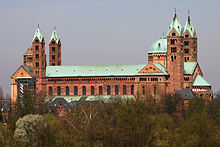
Back Domkerk van Speyer Afrikaans كاتدرائية شباير Arabic كاثدرائيه شباير ARZ Шпаерскі сабор Byelorussian Шпаерская катэдра BE-X-OLD Шпайерска катедрала Bulgarian Katedrala u Speyeru BS Catedral d'Espira Catalan Katedrála Panny Marie a svatého Štěpána (Špýr) Czech Speyerdomen Danish
| Speyer Cathedral | |
|---|---|
| The Imperial Cathedral Basilica of the Assumption and St Stephen | |
Dom zu Unserer lieben Frau in Speyer | |
 | |
 | |
| 49°19′02″N 8°26′33″E / 49.3172°N 8.4424°E | |
| Location | Speyer |
| Country | Germany |
| Denomination | Roman Catholic |
| Website | www |
| History | |
| Founded | 1030 |
| Founder(s) | Conrad II |
| Consecrated | 1061 |
| Architecture | |
| Functional status | Cathedral |
| Heritage designation | UNESCO World Heritage Site |
| Style | Romanesque |
| Administration | |
| Diocese | Diocese of Speyer |
| Clergy | |
| Bishop(s) | Karl-Heinz Wiesemann |
| Type | Cultural |
| Criteria | ii |
| Designated | 1981 (5th session) |
| Reference no. | 168 |
| Region | Europe and North America |
| Property | 0.558 ha (1.38 acres) |
Speyer Cathedral, officially the Imperial Cathedral Basilica of the Assumption and St Stephen, in Latin: Domus sanctae Mariae Spirae (German: Dom zu Unserer lieben Frau in Speyer) in Speyer, Germany, is the seat of the Roman Catholic Bishop of Speyer and is suffragan to the Roman Catholic Archdiocese of Bamberg. The cathedral, which is dedicated to St. Mary, patron saint of Speyer ("Patrona Spirensis") and St. Stephen is generally known as the Kaiserdom zu Speyer (Imperial Cathedral of Speyer).[1] Pope Pius XI raised Speyer Cathedral to the rank of a minor basilica of the Roman Catholic Church in 1925.
Begun in 1030 under Conrad II, with the east end and high vault of 1090–1103, the imposing triple-aisled vaulted basilica of red sandstone is the "culmination of a design which was extremely influential in the subsequent development of Romanesque architecture during the 11th and 12th centuries".[2] As the burial site for Salian, Staufer and Habsburg emperors and kings the cathedral is regarded as a symbol of imperial power.[3][4] With the Abbey of Cluny in ruins, it is the largest remaining Romanesque church and building.[5][6] It is considered to be "a turning point in European architecture",[7] one of the most important architectural monuments of its time[8] and one of the finest Romanesque monuments.[9][10][11]
In 1981, the cathedral was added to the UNESCO World Heritage List of culturally important sites as "a major monument of Romanesque art in the German Empire".[2][12][13][14]
- ^ speyer.de | Speyer Cathedral Archived 13 June 2006 at the Wayback Machine. Information from home page. Retrieved 5 December 2006.(in English)
- ^ a b Cite error: The named reference
ICOMOSwas invoked but never defined (see the help page). - ^ Máté Major: Geschichte der Architektur, Vol. 2, Akadémiai Kiadó, Budapest, 1979, special German edition 1988
- ^ dtv-Atlas zur Baukunst, Vol. 2, 1981, Deutscher Taschenbuch Verlag, Munich, ISBN 3-423-03021-6
- ^ "Speyer Cathedral".
- ^ "Der Kaiserdom zu Speyer – Bauwerk". Archived from the original on 2 January 2016. Retrieved 3 March 2009.
- ^ Cole, Emily, General Editor, Bulfinch Press, Little, Brown and Co., 2002, Boston, USA, ISBN 0-8212-2774-2
- ^ Oursel, Raymond, Stierlin, Henri: Architektur der Welt, Vol. 4: Romanik, Benedikt Taschen Verlag Berlin/Editions Office Du Livre, Lausanne, p. 129
- ^ Stalley, Roger: Early Medieval Architecture, Oxford University Press, Oxford, Great Britain, 1999, ISBN 0-19-210048-3, pp. 214–215
- ^ "Romanesque architecture and art | Infoplease".
- ^ "Romanesque Architecture And Art | Encyclopedia.com".
- ^ "Der Kaiserdom zu Speyer – Zahlen, Namen, Fakten für besonders Eilige". Archived from the original on 10 December 2015. Retrieved 1 March 2009.
- ^ Dethard von Winterfeld. Romanik am Rhein. Stuttgart 2001, p. 66
- ^ "Speyer Cathedral". Welterbestätten Deutschland. UNESCO. Archived from the original on 8 August 2007. Retrieved 5 December 2006.